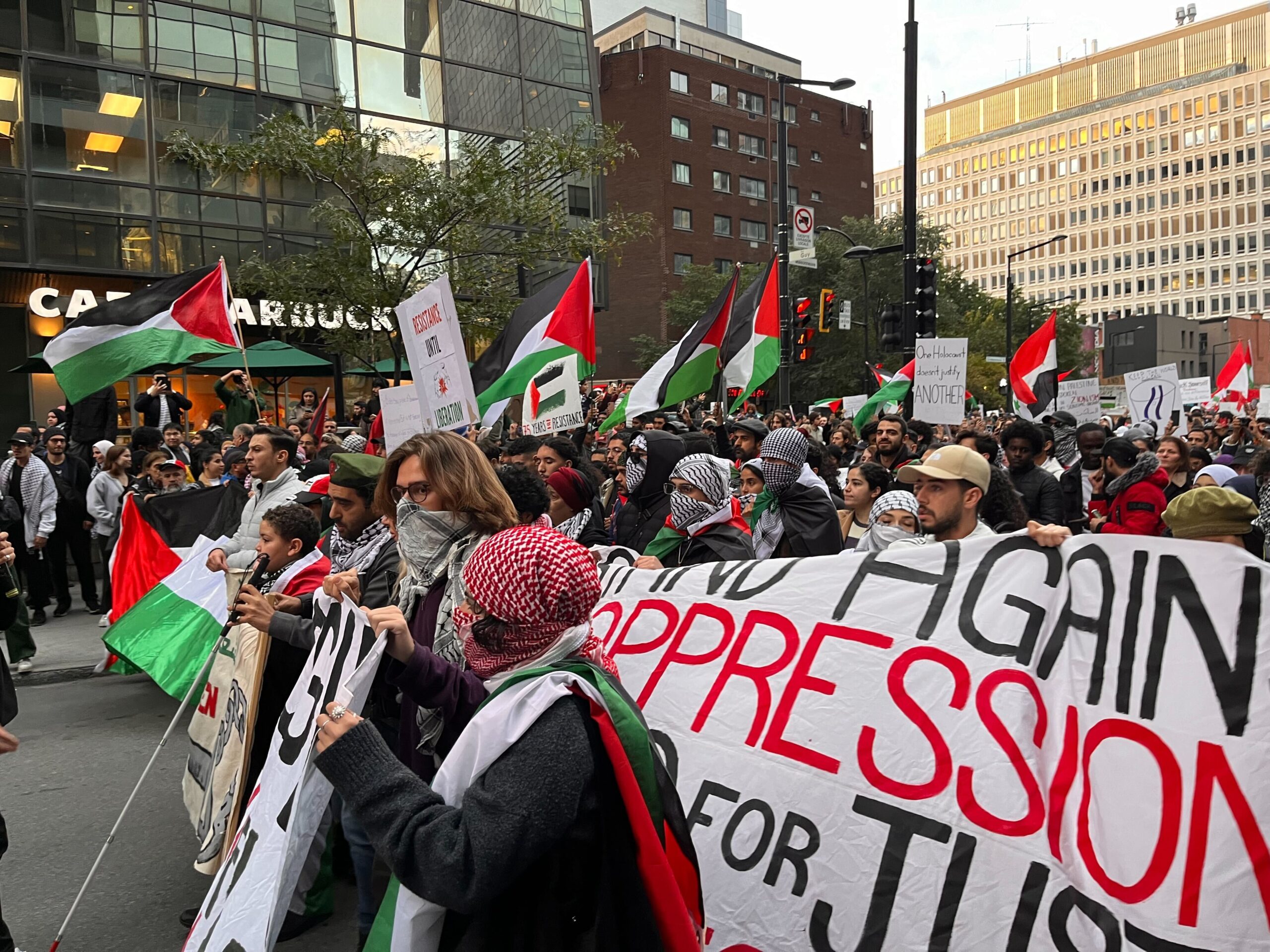On a cool fall day, while the air thawed and blue skies blazed, onlookers stood in awe of the roaring Niagara Falls, its surrounding waterfalls and the calming waters of the Niagara River. In the distance, the thundering thud was pierced by the cacophony of Palestinian songs and passionate cries for justice at a demonstration calling for action and raising awareness about the continued violations of Palestinian rights and the relentless slow-motion genocide they face. Situated in front of one of the world’s major natural spectacles, this was more than a demonstration of solidarity it was an affirmation that peaceful assembly remains a universal right, and that human rights and justice are inalienable ideals that no state can rightfully take away.
There was good symbolism in this selection of location, for Niagara Falls has been long identified with the incessant torrent of water that powers its creation, the relentless human passion for its exploration and the fundamental urge it represents to live on. Organisers and participants felt that this picturesque backdrop could attract a great amount of attention to their message. By their speeches, chants and pictures, they would attempt to educate the world and prod people of goodwill to take action, to stand up for Palestine in the struggle for a just peace.
The Genesis of the Niagara Falls Palestine Protest
As statements against Zionism gained momentum, activists and organisations committed to the Palestinian struggle conceived the Niagara Falls demonstration. They were an alliance of local and international proponents of Palestinian rights. Located at another symbol of imperial divisions and domination, they imagined Niagara Falls as a stage where their protest would reverberate as far afield as Palestine. Months prior to their action, organisers mobilised logistics, permits and publicity. Their objective was to plan a demonstration that would be peaceful, pointed and impactful.
Organisers led up to the protest through extensive outreach strategies contacting different communities and organisations, publicising through social media campaigns, press releases and community meetings to ensure that the protest would be inviting to different people from different backgrounds and communities. Solidarity meanwarecritical. These youth invited people to join them in solidarity. This was a display of generational, communal solidarity. They weren’t inviting people to stand with them, but to stand alongside them. Unity is strength and it was crucial, as we saw reflected in the turnout, that they came out in solidarity.
Symbolism of Niagara Falls in the Protest
Niagara Falls was chosen not only for its visibility but also because of its symbolism. The falls have come to represent natural power and natural beauty, and are today often used as a metaphor for the Palestinian body politic. The constant flow of water, symbolising the persistence and vitality of the memorial effort (and the Palestinian people’s support), echoed the phrasing seen in the flyer: ‘Nothing in the world can stop the water flowing over Niagara Falls. Nothing on earth can stop the Palestinian people in their quest for freedom and self-determination.’ The ‘Wet’ memorial effort was not the first nor the last symbolic action connected to Niagara Falls.
The scenery provided a powerful contrast between the serenity of the landscape, and the urgency of the protesters’ demands for justice. And as the falls continued to rush past, the respite granted us the chance to ponder the poignant contrast between two extremes; one hopes the other would not. The struggle for human rights and dignity is relentless, and we must never forget these Palestinians do not rest. That was the message the Falls wanted me to take away with me.
Voices of the Protest: Speeches and Personal Stories
Three hours of protesting were punctuated by speeches by various organisers, community leaders and people directly impacted by conflict from Palestine. Speeches of this nature were integral to this event as they can sometimes be the only space for the repressed to express themselves. Speakers addressed the audience in an attempt to navigate the difficult terrain of directly humanising the issue. Speakers narrated the emotional, human stories of those affected by the Palestinian conflict. They spoke of the loss of their homes, the extinction of entire communities, and the wounds that still bleed. They described the challenges they faced as fathers and mothers trying to raise children in a tense and hostile environment. Their narratives yielded the human side of the conflict.
She was joined by Palestinian refugees and Palestinian solidarity activists whose visceral testimony provided a different but complementary route into the same place: Palestinian lives disrupted by Israeli occupation. In a room full of people huddled around a computer screen, the speakers reminded attendees of the bodily and temporal consequences of a war they usually experience only as political talk. The speeches exhorted everyone to continue to fight for justice and peace in Palestine, not as abstract principles in a classroom dialogue but as concrete possibilities in actual lives.
Visual and Artistic Displays at the Protest
Art was an essential element in the protest at Niagara Falls. Yellow Fever (2014) by Omar Barghouti, Hassan Hajjaj, and Tomer Shalom. Courtesy of the artistsThe wall itself was a focal point and was covered with a rooftop a political statement that the people of Palestine should not have to live in a similar state of defenselessness. Banners, posters and flags were left inside and outside the compound, often with dramatic or thought-provoking slogans and images. One Palestine poster read ‘We will not survive by surviving alone,’ and showed either NC junction or transthoracic echocardiography. An important aspect was the role that art and the themes explored through art played in the performance. Many of the artists are either Palestinians or have worked in Israel, Palestine and Palestine refugee camps. The artists and designers worked closely together with each other and with the protesters, creating images that could be meaningful to both the stand-off’s witnesses and those who read about the performance in the national and international media.
Many of the speeches were framed by a large mural that covered the side of a building and depicted scenes from Palestinian life from oppression to optimism. Performers and musicians also added to the protest’s repertoire through their talent and skill. Their performances intensified the atmosphere, transformed the mode of expression, and bolstered the visual and verbal narratives in often situated, interactive and surprising ways. All of these artistic dimensions collapsed the boundaries between those strictly concerned with politics and those focused on culture, creating a horizon where celebratory cultural expression merged with political protest.
Media Coverage and Public Reception
There was widespread coverage of the Niagara Falls protest by local, national and international media. Reporters from news outlets as varied as the Niagara Falls Gazette and dozens of national and international publications made sure that readers, viewers and listeners understood why the protesters were there and what they were shouting, yelling and shouting about. Journalists and photographers were integral to the experience of the protest, capturing the sounds and sights for audiences who were not present at Niagara Falls.
Reactions from the general public were mostly positive, with some calling the protest one of the best demonstrations they’d ever attended. Photos and status updates on social media platforms have been shared, contributing to spreading the word. Nonetheless, there have been some negative reactions, with some people questioning the usefulness of such protests. Overall, the response indicates the importance of raising awareness and engaging in a discussion on the Palestinian issue.
The Impact and Future Implications of the Protest
Of course, those involved in the organising of the Niagara Falls protest or in gathering signatures on the letter expect that the end of their creative act won’t be the end of BDS. The victory could be lasting, but that outcome hasn’t yet been determined. Admired and immediately criticised at the time, the letter and the Niagara Falls protest have fuelled conversation and action well beyond 12 August. It sparked a series of followup events, meetings and campaigns.
As for the future, the protest showed how demonstrations in the future could couple landmark venues with crucial messages. In our view, the success of Niagara Falls might prove inspirational for other organisers and activists who wish to advance the Palestinian cause: how can they turn this iconic and symbolic tactic into something else? The story of Niagara Falls nicely shows us that sometimes events can happen, but only if people make them happen, on a righteous day, at the right time, and under the right circumstances.
Conclusion
Niagara Falls protest for Palestine was an impressive and dignified demonstration of the continuing power of peaceful assembly and the global desire for justice. In the midst of one of the most awe-inspiring sights on earth, the protesters delivered a powerful message of solidarity and hope. The widely shared footage of the event served to highlight the plight of Palestine for new audiences, but it also sent a message of the steadfast courage and ongoing struggle of the human rights movement. Niagara Falls will continue to roar and turn, even as the Palestinian cause and global justice movements gain strength from this powerful, persistent and beautifully choreographed display of collective humanity.




